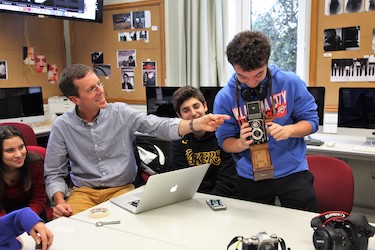A Conversation with Alex Downs, Art and Music Department Head and Photography Teacher
COVER STORY: FINE ARTS ISSUE
A Conversation with Alex Downs, Art and Music Department Head and Photography Teacher
"Kids need visual training that suits the time and the tools to be critical consumers of their own visual world.”
Art Department Head Alex Downs helps students learn photography techniques for different types of cameras
How has the art program developed over time at RC?
20th century art was about skill-building: drawing techniques, dark room procedures, working with clay, camera mechanics and so on. These are still important to teach, but because students can now do many things digitally with the press of a button, knowing these skills becomes less of a priority, and instead concepts become more important in 21st century art programs. For example, editing a photo in a digital dark room means selecting different buttons. You can also undo your work and try other things. More important now is knowing when to use different techniques and what the options are, understanding yourself as an artist and the statement you’re making with your edits. We now talk more about ideas in the classroom because skills are enabled by new technologies.
The world we live in is much more visual than it was twenty or thirty years ago. On our phone we see thousands of images each day. Previously students did not have such a deluge of images. Visual literacy becomes critical: how do we give RC students the tools they need to be critical consumers of all visual media? Students still do hands-on art projects, but they are learning other things as well.
Through which classes is art taught currently?
All prep students take LP Art, which is counted as part of their overall English grade. Creative Arts is a special course for LPs that is ungraded and counts as mandatory LP club hours. We also offer classes for the three AP portfolios: Drawing, 2D Art & Design and 3D Art & Design. These are recommended for Lise 12s, but some L11s take them as well.
What is the role of studying art for students in such a competitive environment as RC?
In the prep year students find out art is something they can study. It is the first time for many of them that they are evaluated and graded in an art class, and the first time it’s not a fringe activity but a core one. They realize they need to put in effort. Visual art is becoming a career option for a growing number of students. Areas like architecture and marketing all require visual proficiency. We’ve gone from the margins to the center along with science, math, engineering and history. Former Department Head Merril Hope-Brown really pushed the department to get there.
What types of artistic output can students experiment with?
Engraving/press/wood block, digital printers, painting and ceramics are just some of the things they can experiment with. We continue to expand the opportunities in both technical and historical/traditional arts. Why not have a student design a work, 3D print it then try to recreate it in ceramics? Kids need visual training that suits the time and the tools to be critical consumers of their own visual world. The students also create their own shows, like the annual student exhibition around campus.
What type of feedback do you get?
Students say the most important things they acquire from art classes are design-thinking skills. Methods and protocols are used in class for looking at work. Learning how to look carefully and assess is also what alumni say made a difference: These are essential skills for doctors and engineers, too.
Asrın Sevinç RC 19 recently wrote me the following about an experience she had at university: “I especially wanted to write to you after an instance in my Reading and Composition class on Film. We were supposed to analyze two minutes of a movie in terms of techniques. I found myself writing this essay in about 2 hours, while it took my friends days to complete. My professor was very impressed by my analysis and gave me an A++. The photography class at RC had a very important impact in my life and the way I look at things. Although I hadn't noticed it back when you would take us to Sanayi Mahallesi for the photoshoots, looking back, I highly appreciate the way you pushed us to carefully look around us and see the unseen, even when it was pouring with rain!”
How are art lessons done during the pandemic?
Art kits were sent to all the Lise Preps in portfolios, so they could start their classes from home on the first day of school. The portfolio could fit A-4 size works and contained several types of paper, colored pencils, graphite pencils, a brush and a ruler. There are also videos on how to do some of the projects.
Art is now part of their lives rather than something they do at school. Photos are taken at home, and students are interacting with their family members more. They are also working with materials they would have thrown away and are learning that a material used for one thing may also be valuable for another thing – repurposing.
Published February 2021





